
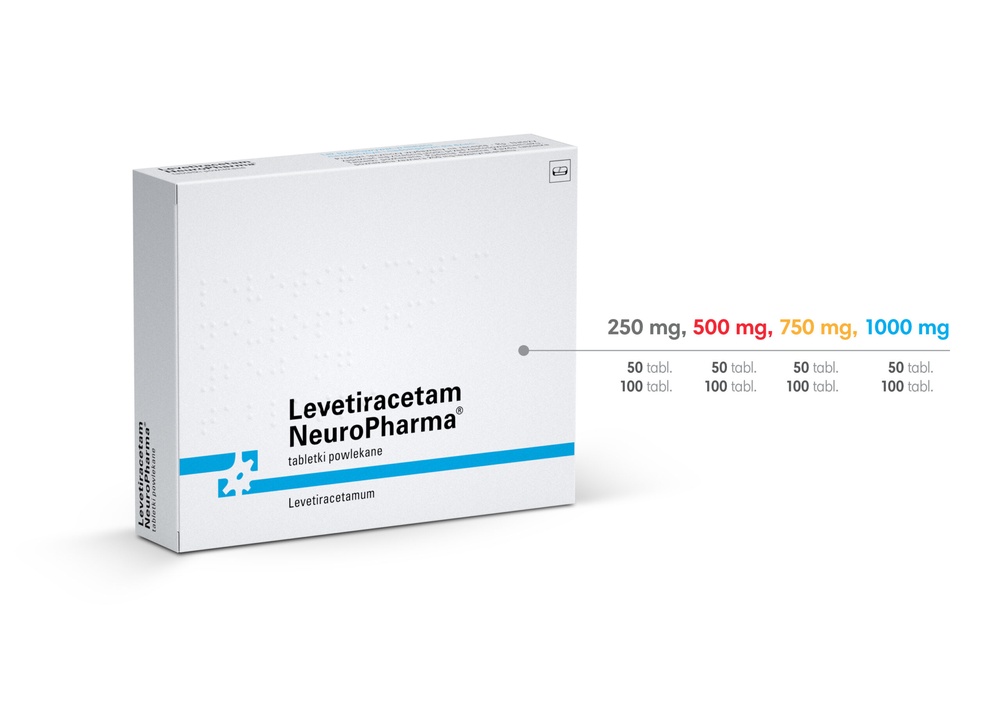
Levetiracetam Neuropharma

Ask a doctor about a prescription for Levetiracetam Neuropharma

How to use Levetiracetam Neuropharma
LEAFLET INCLUDED IN THE PACKAGE: PATIENT INFORMATION
Levetiracetam NeuroPharma, 100 mg/ml, oral solution
Levetiracetam
Read the leaflet carefully before taking the medicine or giving it to a child, as it contains important information for the patient.
- Keep this leaflet, you may need to read it again.
- In case of any doubts, consult a doctor or pharmacist.
- This medicine has been prescribed specifically for you. Do not pass it on to others. The medicine may harm another person, even if their symptoms are the same.
- If the patient experiences any side effects, including any not listed in this leaflet, they should tell their doctor or pharmacist. See section 4.
Table of contents of the leaflet
- 1. What is Levetiracetam NeuroPharma and what is it used for
- 2. Important information before taking Levetiracetam NeuroPharma
- 3. How to take Levetiracetam NeuroPharma
- 4. Possible side effects
- 5. How to store Levetiracetam NeuroPharma
- 6. Contents of the package and other information
1. What is Levetiracetam NeuroPharma and what is it used for
Levetiracetam is an antiepileptic medicine (used to treat seizures in epilepsy).
Levetiracetam NeuroPharma is used:
- as monotherapy (using only Levetiracetam NeuroPharma) in adults and adolescents from 16 years of age with newly diagnosed epilepsy, for the treatment of certain types of epilepsy. Epilepsy is a condition where patients have recurring seizures. Levetiracetam is used to treat a type of epilepsy where seizures initially occur in one part of the brain, but can then spread to larger areas of both hemispheres of the brain (partial seizures with or without secondary generalization). The doctor has prescribed levetiracetam to reduce the number of seizures.
- as an adjunctive therapy (in addition to another antiepileptic medicine):
- in adults, adolescents, and children from 1 month of age, for the treatment of partial seizures with or without secondary generalization,
- in adults and adolescents from 12 years of age with juvenile myoclonic epilepsy, for the treatment of myoclonic seizures (short, shock-like muscle contractions),
- for the treatment of primary generalized tonic-clonic seizures (large seizures, including loss of consciousness) in adults and adolescents from 12 years of age with idiopathic generalized epilepsy (a type of epilepsy that is likely to have a genetic basis).
2. Important information before taking Levetiracetam NeuroPharma
When not to take Levetiracetam NeuroPharma:
- • if the patient is allergic to levetiracetam, pyrrolidine derivativesor to any of the other ingredients of this medicine (listed in section 6).
Warnings and precautions
Before starting treatment with Levetiracetam NeuroPharma, consult a doctor:
- If kidney disease has been diagnosed in the patient, Levetiracetam NeuroPharma should be used as directed by the doctor. The doctor may decide to adjust the dosage.
- If any slowing of growth or unexpected premature puberty has been observed in the child, contact a doctor.
- In some patients treated with antiepileptic medicines such as Levetiracetam NeuroPharma, thoughts of self-harm or suicidal thoughts have occurred. In case of symptoms of depression and/or suicidal thoughts, contact a doctor.
Tell the doctor or pharmacist if any of the following side effects worsen or persist for more than a few days:
- Abnormal thoughts, irritability, or more aggressive reactions than usual, or significant changes in mood or behavior noticed by the patient or their family and friends.
Children and adolescents
- In children and adolescents under 16 years of age, Levetiracetam NeuroPharma should not be used as monotherapy (only Levetiracetam NeuroPharma).
Levetiracetam NeuroPharma and other medicines
Tell the doctor or pharmacist about all medicines the patient is taking, has recently taken, or plans to take. Do not take macrogol (a medicine used for constipation) 1 hour before and 1 hour after taking levetiracetam, as it may reduce the effect of levetiracetam.
Pregnancy and breastfeeding
If the patient is pregnant or breastfeeding, thinks they may be pregnant, or plans to have a child, they should consult a doctor or pharmacist before taking this medicine.
Levetiracetam NeuroPharma can be used during pregnancy only if the doctor considers it necessary after careful evaluation..
Do not stop treatment without discussing it with the doctor.
The risk of congenital defects in the fetus cannot be completely ruled out.
During treatment, breastfeeding is not recommended.
Driving and operating machinery
Levetiracetam NeuroPharma may impair the ability to drive and operate tools or machines, as taking Levetiracetam NeuroPharma can cause drowsiness. This is more likely at the beginning of treatment or after increasing the dose of the medicine.
Driving and operating machinery are not recommended until the effect of the medicine on the patient's ability to perform these activities is known.
Levetiracetam NeuroPharma contains maltitol
Levetiracetam NeuroPharma, oral solution, contains maltitol. If the patient has previously been diagnosed with intolerance to some sugars, they should consult a doctor before taking the medicine.
Levetiracetam NeuroPharma, oral solution, contains methyl parahydroxybenzoate (E218) and propyl parahydroxybenzoate (E216)
Levetiracetam NeuroPharma, oral solution, contains methyl parahydroxybenzoate (E218) and propyl parahydroxybenzoate (E216), which may cause an allergic reaction (delayed).
3. How to take Levetiracetam NeuroPharma
This medicine should always be taken as directed by the doctor. In case of doubts, consult a doctor or pharmacist.
Levetiracetam NeuroPharma must be taken twice a day, in the morning and evening, at approximately the same time every day.
The oral solution should be taken as directed by the doctor.
Monotherapy:
Dose for adults and adolescents (from 16 years of age)
For patients over 4 years of age, the appropriate dose should be measured using the 10 ml syringe provided with the package.
Usual dose:
Levetiracetam NeuroPharma should be taken twice a day, in two equal doses; a single dose is between 5 ml (500 mg) and 15 ml (1500 mg).
If the patient is taking the medicine for the first time, the doctor will initially prescribe a smaller dose for 2 weeks, and then the usual dose.
Adjunctive therapy:
Dose for adults and adolescents (from 12 to 17 years of age)
For patients over 4 years of age, the appropriate dose should be measured using the 10 ml syringe provided with the package.
Usual dose:
Levetiracetam NeuroPharma should be taken twice a day, in two equal doses; a single dose is between 5 ml (500 mg) and 15 ml (1500 mg).
Dose for children from 6 months of age and older
The doctor will prescribe the most suitable form of Levetiracetam NeuroPharma, depending on the age, weight, and dose.
For children from 6 months to 4 years of age, the appropriate dose should be measured using the 3 ml syringe provided with the package.
For children over 4 years of age, the appropriate dose should be measured using the 10 ml syringe provided with the package.
Usual dose
Levetiracetam NeuroPharma should be taken twice a day, in two equal doses; a single dose is between 0.1 ml (10 mg) and 0.3 ml (30 mg) per kilogram of the child's body weight. (Examples of doses are presented in the table below).
Dose for children from 6 months of age and older
| Body weight | Initial dose: 0.1 ml/kg body weight twice a day | Maximum dose: 0.3 ml/kg body weight twice a day |
| 6 kg | 0.6 ml twice a day | 1.8 ml twice a day |
| 8 kg | 0.8 ml twice a day | 2.4 ml twice a day |
| 10 kg | 1 ml twice a day | 3 ml twice a day |
| 15 kg | 1.5 ml twice a day | 4.5 ml twice a day |
| 20 kg | 2 ml twice a day | 6 ml twice a day |
| 25 kg | 2.5 ml twice a day | 7.5 ml twice a day |
| from 50 kg | 5 ml twice a day | 15 ml twice a day |
Dose for infants (from 1 month to less than 6 months of age):
For children from 1 month to less than 6 months of age, the appropriate dose should be measured using the 1 ml syringe provided with the package.
Usual dose:
Levetiracetam NeuroPharma should be taken twice a day, in two equal doses; a single dose is between 0.07 ml (7 mg) and 0.21 ml (21 mg) per kilogram of the infant's body weight. (Examples of doses are presented in the table below).
Dose for infants (from 1 month to less than 6 months of age)
| Body weight | Initial dose: 0.07 ml/kg body weight twice a day | Maximum dose: 0.21 ml/kg body weight twice a day |
| 4 kg | 0.3 ml twice a day | 0.85 ml twice a day |
| 5 kg | 0.35 ml twice a day | 1.05 ml twice a day |
| 6 kg | 0.45 ml twice a day | 1.25 ml twice a day |
| 7 kg | 0.5 ml twice a day | 1.5 ml twice a day |
Method of administration
After measuring the correct dose using the appropriate syringe, Levetiracetam NeuroPharma, oral solution, can be diluted in a glass of water or a baby bottle.
Levetiracetam NeuroPharma, oral solution, can be taken with or without food. After oral administration, levetiracetam may leave a bitter taste.
Instructions for preparing the medicine for use:
- Open the bottle: press the cap and turn it in the opposite direction of the clock hands (figure 1).
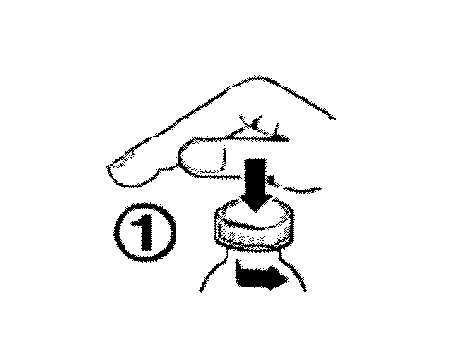
- Place the oral syringe connector in the bottle neck (figure 2). Make sure it is well secured.
- Insert the dosing syringe into the connector opening (figure 2).
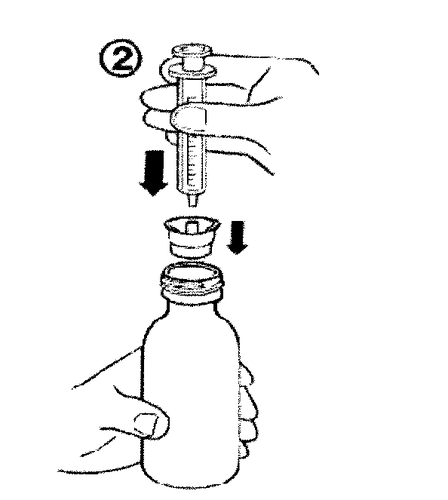
- Invert the bottle (figure 3).
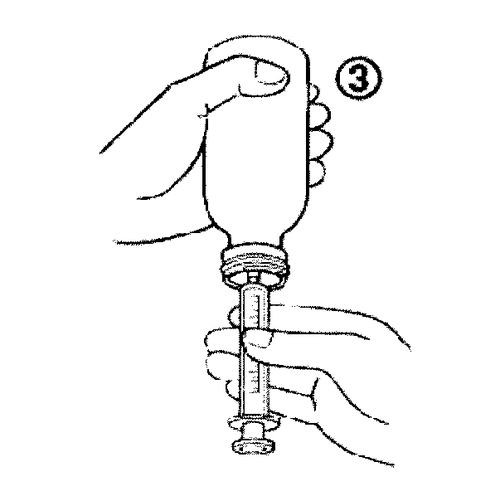
- Draw a small amount of the solution into the oral syringe by pulling the plunger down (figure 4A), then, by pushing the plunger, remove air bubbles from the syringe (figure 4B). Finally, pull the plunger down to the mark on the scale corresponding to the dose prescribed by the doctor in milliliters (ml) (figure 4C).

- Invert the bottle. Remove the oral syringe from the connector.
- Empty the contents of the oral syringe into a glass of water or a baby bottle, pressing the syringe plunger (figure 5).
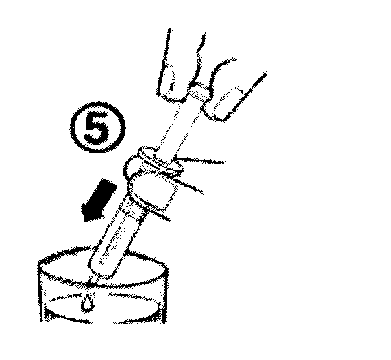
- Drink the entire contents of the glass/baby bottle.
- Rinse the oral syringe with water (figure 6).
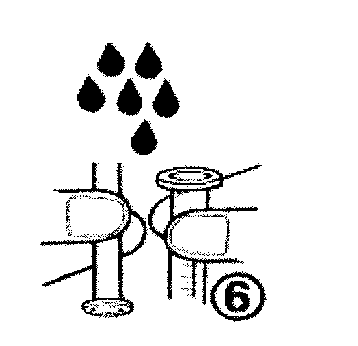
- Close the plastic bottle with the cap.
Duration of treatment
Levetiracetam NeuroPharma is used for long-term treatment. Treatment with Levetiracetam NeuroPharma should be continued for as long as the doctor recommends.
Do not stop treatment without consulting the doctor, as this may cause an increase in the frequency of seizures.
Taking a higher dose of Levetiracetam NeuroPharma than recommended
Possible side effects of overdosing on Levetiracetam NeuroPharma include drowsiness, agitation, aggression, decreased alertness, respiratory depression, and coma.
In case of taking a higher dose of the medicine than recommended, consult a doctor or pharmacist immediately. The doctor will recommend the best possible treatment for the overdose.
Missing a dose of Levetiracetam NeuroPharma
Consult the doctor if one or more doses of the medicine have not been taken.
Do not take a double dose to make up for a missed dose.
Stopping treatment with Levetiracetam NeuroPharma
If treatment with Levetiracetam NeuroPharma is to be stopped, the medicine should be discontinued gradually to avoid increasing the frequency of epileptic seizures. If the doctor decides to stop treatment, they will also inform how to gradually discontinue the medicine.
In case of any further doubts about taking this medicine, consult a doctor or pharmacist.
4. Possible side effects
Like all medicines, this medicine can cause side effects, although not everybody gets them.
Inform the doctor or contact the nearest hospital emergency department immediately if the patient experiences:
- weakness, dizziness, fainting, or breathing difficulties, as these symptoms may indicate a severe allergic reaction (anaphylaxis);
- swelling of the face, lips, tongue, and throat (Quincke's edema);
- flu-like symptoms and rash on the face and then on the whole body, accompanied by high fever, elevated liver enzymes in blood tests, increased levels of a certain type of white blood cell (eosinophilia), and enlarged lymph nodes (DRESS syndrome [drug rash with eosinophilia and systemic symptoms]);
- symptoms such as decreased urine output, fatigue, nausea, vomiting, confusion, and swelling of the feet, ankles, or legs, as this may be a sign of sudden kidney function deterioration;
- a skin rash that can cause blisters and looks like small targets (a dark central spot surrounded by a lighter area and a dark ring around) (erythema multiforme);
- a widespread rash with blisters and peeling skin, occurring mainly in the area of the mouth, eyes, nose, and genitals (Stevens-Johnson syndrome);
- a more severe form of rash causing skin peeling over more than 30% of the body surface (toxic epidermal necrolysis);
- signs of serious mental changes or noticing in the patient signs of disorientation, drowsiness (lack of sleep), memory loss (loss of memory), memory disorders (forgetfulness), behavioral disorders, or other neurological symptoms, including involuntary or uncontrolled movements. These may be symptoms of encephalopathy.
The most common side effects reported are: nasal congestion, drowsiness, headache, fatigue, and dizziness. At the beginning of treatment or when increasing the dose, side effects such as drowsiness, fatigue, or dizziness may occur more frequently. These effects should decrease over time.
Very common:may occur in more than 1 in 10 patients
- nasal congestion;
- drowsiness, headache. Common:may occur in up to 1 in 10 patients
- loss of appetite;
- depression, hostility, or aggression, anxiety, insomnia, nervousness, or irritability;
- seizures, balance disorders, dizziness (feeling of spinning), lethargy (lack of energy and enthusiasm), tremors (involuntary trembling);
- dizziness (feeling of spinning);
- cough;
- abdominal pain, diarrhea, dyspepsia (indigestion), vomiting, nausea;
- rash;
- asthenia/fatigue (exhaustion). Uncommon:may occur in up to 1 in 100 patients
- decreased platelet count, decreased white blood cell count;
- weight loss, weight gain;
- suicidal thoughts and attempts, mental disorders, abnormal behavior, hallucinations, anger, disorientation, panic attacks, emotional instability/mood changes, agitation;
- memory loss (loss of memory), memory disorders (forgetfulness), ataxia (coordination disorder), paresthesia (tingling), attention disorders;
- double vision, blurred vision;
- elevated/liver function test abnormalities;
- hair loss, rash, itching;
- muscle weakness, muscle pain;
- injuries. Rare:may occur in up to 1 in 1000 patients
- infection;
- decreased count of all blood cell types;
- severe allergic reactions (DRESS syndrome [drug rash with eosinophilia and systemic symptoms], anaphylactic reaction [severe and serious allergic reaction], Quincke's edema [swelling of the face, lips, tongue, and throat]);
- decreased sodium levels in the blood;
- suicide, personality disorders (behavioral disorders), thinking disorders (slow thinking, inability to concentrate);
- delirium;
- encephalopathy (detailed description of symptoms can be found in the subsection "Inform the doctor immediately");
- involuntary muscle contractions of the head, torso, and limbs, difficulty controlling movements, hyperkinesia (overactivity);
- pancreatitis;
- liver function disorders, hepatitis;
- sudden kidney function deterioration;
- a skin rash that can cause blisters and looks like small targets (a dark central spot surrounded by a lighter area and a dark ring around) (erythema multiforme), a widespread rash with blisters and peeling skin, occurring mainly in the area of the mouth, eyes, nose, and genitals (Stevens-Johnson syndrome), and a more severe form of rash causing skin peeling over more than 30% of the body surface (toxic epidermal necrolysis);
- rhabdomyolysis (breakdown of striated muscle) and accompanying elevated creatine phosphokinase levels in the blood. The frequency of occurrence is significantly higher in Japanese patients compared to non-Japanese patients;
- stuttering or difficulty walking.
Reporting side effects
If any side effects occur, including any not listed in this leaflet, tell the doctor or pharmacist. Side effects can be reported directly to the Department of Monitoring of Adverse Reactions to Medicinal Products, Medical Devices, and Biocidal Products of the Office for Registration of Medicinal Products, Medical Devices, and Biocidal Products,
Al. Jerozolimskie 181C
02-222 Warsaw
Phone: +48 22 49 21 301
Fax: +48 22 49 21 309
Website: https://smz.ezdrowie.gov.pl
Side effects can also be reported to the marketing authorization holder.
Reporting side effects will help gather more information on the safety of the medicine.
5. How to store Levetiracetam NeuroPharma
Keep the medicine out of sight and reach of children.
Do not use this medicine after the expiry date stated on the package and bottle after "Expiry date" and (or) "EXP". The expiry date refers to the last day of the month.
Do not use after 6 months from the date of first opening the bottle.
There are no special precautions for storing the medicine.
Medicines should not be disposed of via wastewater or household waste. Ask a pharmacist how to dispose of unused medicines. This will help protect the environment.
6. Contents of the package and other information
What Levetiracetam NeuroPharma, 100 mg/ml, contains
- The active substance is levetiracetam. Each milliliter contains 100 mg of levetiracetam.
- Other ingredients are: sodium citrate, anhydrous citric acid, purified water, methyl parahydroxybenzoate (E 218), propyl parahydroxybenzoate (E 216), ammonium glycyrrhizinate, glycerol, maltitol (E 965), acesulfame potassium (E 950), Fantasie flavor, Contramarum flavor.
What Levetiracetam NeuroPharma, 100 mg/ml, looks like and what the package contains
Clear oral solution, colorless or slightly brown.
A glass bottle containing 300 ml of Levetiracetam NeuroPharma (for children from 4 years of age, adolescents, and adults) packed in a cardboard box containing a 10 ml oral syringe with a scale every 0.25 ml and a syringe connector
A glass bottle containing 150 ml of Levetiracetam NeuroPharma (for infants and children from 6 months to 4 years of age) packed in a cardboard box containing a 3 ml oral syringe with a scale every 0.1 ml and a syringe connector
A glass bottle containing 150 ml of Levetiracetam NeuroPharma (for infants and children from 1 month to 6 months of age) packed in a cardboard box containing a 1 ml oral syringe with a scale every 0.05 ml and a syringe connector.
Pack sizes of 150 ml and 300 ml.
Hospital packs of 1500 ml (5 x 300 ml or 10 x 150 ml).
Not all pack sizes may be marketed.
Marketing authorization holder and manufacturer
neuraxpharm Arzneimittel GmbH
Elisabeth-Selbert-Straße 23
40764 Langenfeld
Germany
To obtain more detailed information, contact the representative
of the marketing authorization holder in Poland:
Neuraxpharm Polska sp. z o.o.
ul. Domaniewska 37
02-672 Warsaw
[email protected]
Date of last revision of the leaflet:05/2020
- Country of registration
- Active substance
- Prescription requiredYes
- Manufacturer
- Importerneuraxpharm Arzneimittel GmbH
- This information is for reference only and does not constitute medical advice. Always consult a licensed doctor before taking any medication. Oladoctor is not responsible for medical decisions based on this content.
- Alternatives to Levetiracetam NeuropharmaDosage form: Tablets, 250 mgActive substance: levetiracetamPrescription requiredDosage form: Tablets, 500 mgActive substance: levetiracetamPrescription requiredDosage form: Tablets, 750 mgActive substance: levetiracetamPrescription required
Alternatives to Levetiracetam Neuropharma in other countries
The best alternatives with the same active ingredient and therapeutic effect.
Alternative to Levetiracetam Neuropharma in Spain
Alternative to Levetiracetam Neuropharma in Ukraine
Online doctors for Levetiracetam Neuropharma
Discuss dosage, side effects, interactions, contraindications, and prescription renewal for Levetiracetam Neuropharma – subject to medical assessment and local rules.







